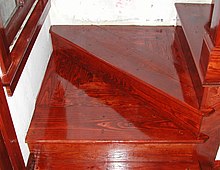**History of Varnish:**
– The word varnish comes from Mediaeval Latin vernix, meaning odorous resin.
– Early varnishes were developed by mixing resin with a solvent and applying them with a brush.
– Varnishing was a technique well known in ancient Egypt and in the history of East and South Asia.
**Safety Precautions:**
– Many varnishes and drying oils are flammable and may spontaneously combust.
– Flammable components include plant-derived oils, synthetic oils, and resins.
– Manufacturers list safety precautions for storage and disposal of varnishes.
– Proper disposal practices for rags and items used to apply varnish are recommended.
**Components and Curing of Varnish:**
– Varnish traditionally consists of a drying oil, a resin, a thinner or solvent, and a metal drier.
– Film-forming substances in varnishes harden through different processes.
– Environmental factors such as heat and humidity affect drying and curing times.
– Exposure to energy sources like sunlight can speed up the drying and curing process.
**Types of Varnish:**
– Violin varnishing involves a multi-step process with various coats and clear topcoat.
– Shellac is a widely used single-component resin varnish sourced from the lac insect.
– Alkyd varnishes offer good solvent, moisture, and UV resistance.
– Spar varnish was originally for ship spars and offers water resistance and elasticity.
– Polyurethane varnishes are hard, abrasion-resistant, and durable with a tendency to yellow over time.
– Acrylic varnishes are water-borne with high transparency and good UV-resistance.
– Two-part epoxy varnishes are formulated for various applications with different mixing ratios.
**Specific Varnish Types:**
– Shellac: Basis of French polish, available in clear, amber, ruby, and yellow varieties.
– Alkyd: Modern varnishes with good resistance properties and UV-absorbers.
– Spar varnish: Originally for ship spars, now offers elasticity and UV-resistance.
– Drying oils: Commonly used for varnish-like effects in modern applications.
– Polyurethane: Popular for hardwood floors due to its toughness and waterproofing properties.
– Acrylic: Water-borne varnishes with high transparency and good UV-resistance.
– Two-part epoxy: Formulated for various applications with different mixing ratios.
Varnish is a clear transparent hard protective coating or film. It is not to be confused with wood stain. It usually has a yellowish shade due to the manufacturing process and materials used, but it may also be pigmented as desired. It is sold commercially in various shades.


Varnish is primarily used as a wood finish where, stained or not, the distinctive tones and grains in the wood are intended to be visible. Varnish finishes are naturally glossy, but satin/semi-gloss and flat sheens are available.
